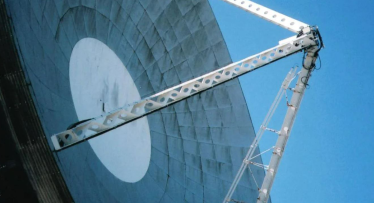How to get more from your MSS satellites and spectrum
By Lewis Davies

Satellite Network Operators struggle to meet demand for new and growing services such as UAVs, direct-to-device, ISR and IoT, yet there are opportunities to significantly increase capacity with the right technology.
Satellite spectrum can loosely be thought of as a highway with different spectrum bands equating to lanes that allow vehicles and their cargo to travel at different speeds (or for data to travel between two ground terminals via a satellite). The faster lanes let lots of vehicles through. The slower lanes provide capacity for those who are not in such a rush. Then there is the shoulder, a channel kept clear for vehicles that may need it in an emergency, much as L-band spectrum is used for emergency communications by maritime and aeronautical safety services.
Managing traffic was less of a problem when demand for roads, or spectrum, was lower. But in recent years, demand has risen for data via satellites thanks to new commercial services, such as those to UAVs, consumer services utilizing standard smartphones, and government applications including Intelligence, Surveillance and Reconnaissance (ISR). Just as it is always expensive and sometimes simply not practical to widen roads after they are built, it is hard to add new spectrum and satellites. This means to serve this growing demand without vast investment, we need to make more of the capacity we have.
The Challenges Of Legacy Satellite Infrastructure
The overarching challenge is that satellite spectrum faces natural limits. Only so much data can be transmitted on each satellite beam and frequency channel, with each beam constrained to a certain area so it doesn’t interfere with other beams. The width of the frequency channel places a limit on the data rate an individual terminal can support.
The frequency bands are assigned and licenced by international regulators putting a hard limit on the spectrum available. This means that if satellite network operators (SNOs) want to increase their service revenues – by delivering more services over existing spectrum allocation and with existing space infrastructure – they need to do more with what is already available to them.
Whilst the Shannon limit places a theoretical maximum instantaneous data rate for any given communications channel, in practice, looking across an entire satellite network, we are well short of reaching that limit. Therefore, there is plenty of room to optimize practical capacity through improved technologies.
Getting More From Your Spectrum
So, how can SNOs deliver as many services as possible across their spectrum and maximise their returns, without compromising the quality of those services? Perhaps the most significant opportunity is to carve up the allocated spectrum more flexibly. With more flexible frequency allocations, we could squeeze more into the same space. A motorway has three lanes but could fit four if they were narrower, enabling a 33 percent rise in capacity. This would be possible if cars were driven autonomously and could travel with greater precision. Similarly, as communications technologies improve, we can squeeze more data into less radio bandwidth.
Much can also be gained from being more intelligent about how we manage data transfer in time. Just as roads can optimise the flow of heavy traffic by varying signalling and speed limits, satellite communications can control data rates and latencies to get more data through the same channel.
Non-urgent communications – such as once-daily backhauls from less time-critical IoT monitoring sensors –could be offered with a reduced fee if the user accepts that uploads can be scheduled at any time during a 24hour period. For SNOs, this unlocks flexibility and an ability to open capacity at busy times by scheduling non-urgent signals at quiet moments or when gaps arise.
As we become more intelligent, we can also make better use of reserved channels. These channels sit empty most of the time because they may be needed in an emergency. But if we build in flexibility across the whole spectrum, we can quickly create a clear path at any time. Think of a highway full of autonomous vehicles. The moment an ambulance needs to get through, we hold back the queue to join, and make everyone already on the motorway slow down and switch lanes to create a clear path through. This is not just a technical challenge; it will require a shift in thinking from those who see reserved channels as a safe solution. There is no reason it can’t work just as well.
How To Do It
Primarily it is a case of updating ground stations and terminals with new technologies. It is worth noting that, in most cases, the satellite is just a mirror and doesn’t need updating. The complexity exists at the ground station and in the terminal, so these updates can all be done on Earth.
And where do these new, improved technologies come from? An obvious place to look is at the much larger cellular industry, with its similarly large R&D budgets. This could be through the direct use of cellular equipment, possibly with some adaptations for use with satellites, or by applying elements of proven cellular technology to upgrade legacy SATCOM standards. 5G NTN activities within the 3GPP are exploring how cellular equipment can be adapted for direct use with satellites, enabling satellite-terrestrial convergence and lower-cost satellite equipment. However, at least at L- and S-Band mobile satellite service (MSS) frequencies, data rate is currently not a priority for the NTN working group.
In the absence of this being driven by standards, cellular and other wireless technologies could be used in the shortmedium term. A key element of this is Orthogonal Frequency Division Multiple Access (OFDMA), which allows multiple diverse users to share a common radio resource highly efficiently whilst avoiding radio interference between users and allowing channel filtering in the modem to be efficiently implemented digitally. This approach helps maximize overall network capacity and provides the ability to assign the capacity very flexibly across multiple users, potentially helping an SNO obtain more capacity from their satellites and spectrum.
Other applicable cellular techniques include Single Frequency Networks (SFNs), which allow adjacent beams to share the same frequency. These increase spectrum efficiency and capacity but do require interference between beams to be managed. Fortunately, there are a range of techniques to help with this.
A challenge for an SNO considering directly adapting cellular technologies or elements of technology such as OFDMA is how the multi-MHz cellular frequency assignments typically required fit with traditional SATCOM frequency band plans currently utilizing 200KHz or narrower channels.
Whilst there are opportunities to simply join contiguous channels into a wider block, limitations are imposed by the need to support legacy equipment with difficult-to-move operating frequencies. It is also necessary to maintain reserved channels and respect individual countries’ radio licencing conditions. This is brought into sharp focus for SNOs when trying to increase the data capacity of a single terminal. In a 200KHz channel, data rates of near 1Mbps are just achievable. Beyond this, multiple 200KHz channels are needed. If contiguous channels are available, terminal data rates can readily proportionally increase with the number of channels available.
Without contiguous channels, complex techniques such as carrier aggregation are currently needed. A limitation of these techniques is that the terminal is heavy and expensive, making them unsuitable for some applications, such as with lightweight UAVs.
To return to our highway analogy – today’s roads were designed for lots of human drivers, with speed limits and wide markings to avoid collisions. But with future highways, where automated driving systems make decisions such as speed and lane choice across the entire highway, it may be possible to dispense with some of these safety limits and fit in more vehicles at higher speeds, all with less risk.
In the satellite world, with each of the technological advances that might be possible, comes technical detail and limitations to understand and work through. There is no one-size-fits-all. However, by embracing a combination of new technologies, it is possible to realize significantly more capacity for the same finite spectrum.
A business plan establishing a possible ROI for this increased capacity can be created by an SNO, initially identifying the value of different types of increased capacity to them. This can take diverse forms and is seldom as simple as just increasing the data rate of a single, fixed- frequency bandwidth satellite channel. For example, SNOs selling to government customers may find that their ability to sell high-value, high data rate lease services is hampered by the apparent lack of suitable spectrum and capacity. These services are ideally provided using a single frequency block within a beam, allowing lower size, weight, and power (SWaP) terminal equipment to be used, enabling, for instance, greater use in UAV-based reconnaissance applications.

For those selling to the cost-sensitive and higher volume IoT sector, it may be the network’s ability to support a large population of low data rate terminals registered on the network, as opposed to the data requirements of the terminal itself.
The next step to a meaningful business plan is then holistically reviewing its target customer priorities and considering current spectrum, satellite capacity, and frequency usage to identify what capacity enhancements might be possible through selectively altering frequency plans and upgrading air interfaces. This will likely result in conflicting demands requiring complex technical tradeoffs to be analyzed and evaluated independent of individual customer-facing groups. This can be undertaken centrally within an SNO if supported, where needed, by independent technical expertise. With this understanding, a costed roadmap relative to an SNO’s customer priorities, with associated timescales and risk mitigation plan can be developed. Before full commitment to the plan, confidence can be gained through selective sandbox trials and experiments.
In summary, introducing these types of technical solutions depends on an SNO’s customer priorities and needs, backed by a willingness to innovate as some of these ideas involve departures from long-established ways of doing things. Radically altering frequency plans and air interfaces is scary and may need to be introduced gradually. However, those willing to take risks and do things differently often end up leading their industry.
Originally Published in Satellite Evolution



